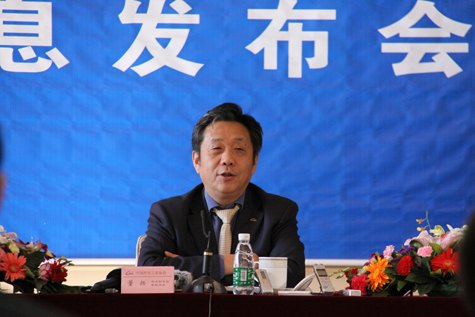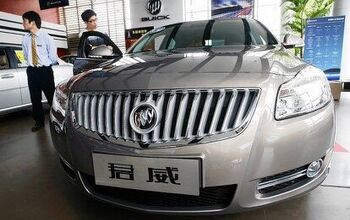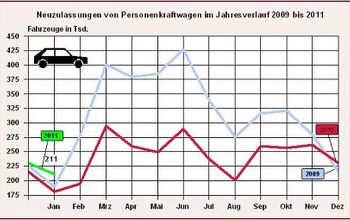China In March 2011: Up 5.36 Percent

Beijing’s war on the ICE notwithstanding, auto sales in China rose by 5.36 percent in March. That is the headline from a Sunday afternoon press conference held by the China Association of Automobile Manufacturers (CAAM). More than 60 journalists were poised to report that for the first time any of them could remember, the Chinese market did sink. But it went the other way. Still up.
In March, a total of 1,828,500 vehicles changed hands in China. For the first quarter, sales were 4,983,800 for an increase of 8.08 percent. (And not 4.98 percent, as AFP erroneously reports.) Production for the first quarter stands at 4,895,800 units for an increase of 7.48 percent.
Passenger vehicle sales still run at a healthy clip, up 6.52 percent in March to 1,347,600 units. For the first three quarters, passenger vehicle sales are up 9.07 percent. (All percentages compared to same period in the previous year.)
Dong Yang, executive vice president and secretary-general of the CAAM, blamed the slower growth rates on the oil price hike, the expiration of tax incentives, auto purchase restrictions in cities like Beijing, and lastly the Japanese earthquakes.
In my humble opinion, the market is simply taking a breather after the record 32 percent run-up to more than 18 million units in 2010. There was a pull-forward effect in the sub 1.6 L class, which still dominates the market. This effect needs to be digested. I had expected a slight decline in Q1. The 18 million Chinese market is intact and it looks like 20 million by year’s end.
What may be in need of service is our patent pending TTAC Chinese market sales oracle. In March, GM China’s sales rose only 1.9 percent across all joint ventures, under-performing the market. But let’s give our oracle a break: For the first quarter, GM China’s sales were up 10 percent, whereas the market rose 9 percent. The oracle is doing alright. A little oil, and it will be fine.
In related news and pursuant to our yesterday’s story on the Chinese license plate roulette, Xinhua reports today that “a total of 491,671 people in Beijing had applied for the monthly lottery of 17,600 license plates for April, which means only one out of 28 will turn out to be winners.” 111,728 new applicants mix in with the luckless from the previous months. If this trend continues, in June your chances of winning a Straight Up in roulette will be better than your odds of winning a license plate in Beijing.

Bertel Schmitt comes back to journalism after taking a 35 year break in advertising and marketing. He ran and owned advertising agencies in Duesseldorf, Germany, and New York City. Volkswagen A.G. was Bertel's most important corporate account. Schmitt's advertising and marketing career touched many corners of the industry with a special focus on automotive products and services. Since 2004, he lives in Japan and China with his wife <a href="http://www.tomokoandbertel.com"> Tomoko </a>. Bertel Schmitt is a founding board member of the <a href="http://www.offshoresuperseries.com"> Offshore Super Series </a>, an American offshore powerboat racing organization. He is co-owner of the racing team Typhoon.
More by Bertel Schmitt
Latest Car Reviews
Read moreLatest Product Reviews
Read moreRecent Comments
- Analoggrotto I don't see a red car here, how blazing stupid are you people?
- Redapple2 Love the wheels
- Redapple2 Good luck to them. They used to make great cars. 510. 240Z, Sentra SE-R. Maxima. Frontier.
- Joe65688619 Under Ghosn they went through the same short-term bottom-line thinking that GM did in the 80s/90s, and they have not recovered say, to their heyday in the 50s and 60s in terms of market share and innovation. Poor design decisions (a CVT in their front-wheel drive "4-Door Sports Car", model overlap in a poorly performing segment (they never needed the Altima AND the Maxima...what they needed was one vehicle with different drivetrain, including hybrid, to compete with the Accord/Camry, and decontenting their vehicles: My 2012 QX56 (I know, not a Nissan, but the same holds for the Armada) had power rear windows in the cargo area that could vent, a glass hatch on the back door that could be opened separate from the whole liftgate (in such a tall vehicle, kinda essential if you have it in a garage and want to load the trunk without having to open the garage door to make room for the lift gate), a nice driver's side folding armrest, and a few other quality-of-life details absent from my 2018 QX80. In a competitive market this attention to detai is can be the differentiator that sell cars. Now they are caught in the middle of the market, competing more with Hyundai and Kia and selling discounted vehicles near the same price points, but losing money on them. They invested also invested a lot in niche platforms. The Leaf was one of the first full EVs, but never really evolved. They misjudged the market - luxury EVs are selling, small budget models not so much. Variable compression engines offering little in terms of real-world power or tech, let a lot of complexity that is leading to higher failure rates. Aside from the Z and GT-R (low volume models), not much forced induction (whether your a fan or not, look at what Honda did with the CR-V and Acura RDX - same chassis, slap a turbo on it, make it nicer inside, and now you can sell it as a semi-premium brand with higher markup). That said, I do believe they retain the technical and engineering capability to do far better. About time management realized they need to make smarter investments and understand their markets better.
- Kwik_Shift_Pro4X Off-road fluff on vehicles that should not be off road needs to die.


































Comments
Join the conversation
is it 5.36% compared to March 2010 or compared to February 2011? This isn't really clear in the article.... If it is compared to March 2010, I think we (again) prove the theory that growth can not be infinite.
BYD is pretty clear. Why is Geely getting crushed?